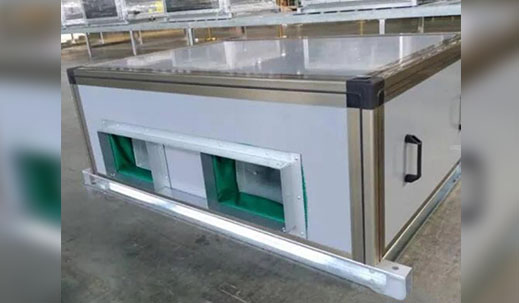The functional sections of the AHU air conditioner generally need to be combined freely according to the specific situation of the user, and the combination sequence of different manufacturers is different.
However, in general, an AHU air conditioner mainly consists of the following functional segments:
Fresh air section
The fresh air section mainly receives outdoor fresh air and precipitates impurities in the fresh air; the fresh air valve is equipped with a damper actuator (switching value), which is interlocked with the fan.
It is recommended to install a temperature sensor in the shade outdoors for return air temperature compensation.
Filter segment
The filter of fresh air is generally the initial effect (or coarse effect) filter, which mainly filters impurities with large volume; the filter after the return air section is generally a medium-effect filter: generally filters impurities with small volume; if it is to purify the air conditioner There will also be sub-efficient and high-efficiency filter sections.
Differential pressure switches should be installed before and after all filter screens to detect the cleanliness of the filter screens. If there are many impurities in the filter screen, an alarm signal will be sent.
Return air section
The return air section is mainly suitable for mixing fresh air and return air; the air valve at the return air outlet is equipped with an air valve actuator (analog value) to adjust the return air volume.
When the outdoor temperature is hot or cold, it can ensure a certain fresh air volume Under the premise, maximize the use of return air, so as to achieve the purpose of energy saving. The exhaust valve at the exhaust port is equipped with a damper actuator, which is interlocked with the return air valve actuator, and the action direction is opposite. Install a temperature and humidity valve on the return air pipeline. The sensor is used to detect the greenhouse temperature of the return air (so as to know the average temperature and humidity in the room), and provides a basis for controlling the cold water valve, heating valve, electric heating and humidifying valve.
Surface cooling section
The surface cooling section is mainly to cool the air sent to the room, and also has the function of cooling and dehumidification (optional), and dehumidification is given priority. The temperature regulating valve (three-way) is installed at the water inlet of the surface cooler.
When the temperature and humidity of the return air reach the set requirements, the temperature regulating valve is closed or closed, and the excess chilled water flows back through the third channel to prevent the regulating valve from being closed. Or when the pressure difference before and after the valve is too large when it is closed, other pipe fittings or water pumps will be damaged, and the service life of the regulating valve will be affected. In addition, an antifreeze switch is installed on the surface of the surface cooler to protect the air conditioning equipment, and is interlocked with the fan and air valve.
Heating section
The heating section is used in winter (or generates temperature after dehumidification and supercooling), and its working principle is the same as that of the surface cooling section. The heating and cooling surface coolers of the two-pipe system are shared.
Electric heating
Electric heating is generally used when the heating section cannot meet the heat requirements or when the temperature is generated after dehumidification and supercooling.
Humidification section
The function of the humidification section is to prevent dry humidification in winter or humidification required by special processes. The humidification method is generally wet film humidification or steam humidification.
Air section
The function of the air supply section is to supply air to the room, also known as the fan section. The air valve at the air supply port is generally equipped with an actuator (switch value, optional function), which is interlocked with the fan.
- HOME
- PRODUCTS
- Mist fog cannon for Dust suppression and Agricualture pesticide
- Axial fan blowers
- SDS Underground Tunnel Ventilation Jet Turbine Fans
- Sound Attenuator
- High Volume Low Speed Industrialfan
- Centrifugal Fan Blower
- Mining ventilation fan blowers
- JK45 Single Motor Primary Mine Ventilation Booster Fans
- DK40 Double (Twin) Motor primary Mine Ventilation Booster Fans
- Fbd auxiliary mine ventilation fan blower
- YBT Mining Explosion-proof Axial Mine Fan Blower
- FBCDZ series anti-explosion main mine fan
- Metal Mine Fan
- K40 Single Motor Mine Ventilation Booster Fans
- Mining Equipments
- Duct And Pipe
- HVAC-AHU-Damper
- Dust collector
- Spare parts
- ABOUT US
- News
- VIDEO
- Order Tracking
- FAQ
- Projects
- CATALOGUE
- CONTACT US

 Español
Español Русский
Русский Tiếng Việt
Tiếng Việt 中文
中文 suomi
suomi Français
Français Português
Português English
English Deutsch
Deutsch Français
Français Español
Español Italiano
Italiano Português
Português Pусский
Pусский



